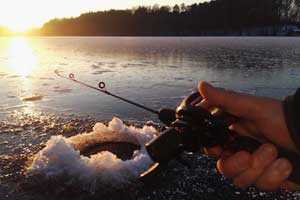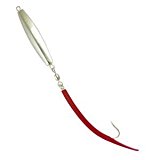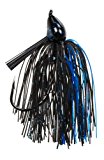Jigs

The jig is one of the most versatile lures, even more so than spoons. They’re considered more successful than using bait. Jig fishing is popular because they can be cast, trolled, fished along the bottom and fished in an up and down fashion.
Jigs initially designed for ice fishing are now popular all year round as casting or vertical jigs
There’s differing opinions about whether the jig is a lure or a weight. We call it a combination of the two (primarily a lure) and include it with the lures.
About Jigs
The weight of a jig correlates directly to how far it can be cast. While this may seem obvious, many an angler gets caught up using the wrong size jig simply because it’s worked well in most situations.
- Jigs worked well can out-fish any live bait.
However, to accomplish this, experience will tell an angler that many jigs are required. You need to choose depending on
- the fish
- conditions
- fishing technique
- weight and size required
Some jigs have natural movement built into them while others require the angler touch of the rod tip to create natural movement.
Leadhead Jigs
 These are also known as bucktails due to the hair or features used to make up the back end of the jig. Like the bucktail, it’s constructed using the same fibers.
These are also known as bucktails due to the hair or features used to make up the back end of the jig. Like the bucktail, it’s constructed using the same fibers.
The primary part of the jig is constructed around the shank of a hook, though some have free swinging hooks. It’s difficult to explain exactly how they appear, as there are so many varieties and there are always exceptions. However this description describes the majority of leadhead jigs out there.
Some jigs are shaped to sink fast in fast currents such as butterbeans and slopeheads. Leadheads constructed from soft plastic tails flap, although they’ll not stand up to many aggressive strikes or battles.
A perfectly well balanced jig will hang upright when simply suspended. Those that are balanced with their hocks low create an imbalance important for vertical jigging.
For small freshwater run fish, jigs are best attached directly to the line. This is especially good fishing for panfish found in brackish water.
Diamond Jigs
 Diamond jigs have the same profile as leadhead jigs with a few differences. One of those differences is its shape. All diamond jigs have a diamond shape. Like the leadhead, they can be fished in many ways from casting on a boat, bridge or even for ice fishing.
Diamond jigs have the same profile as leadhead jigs with a few differences. One of those differences is its shape. All diamond jigs have a diamond shape. Like the leadhead, they can be fished in many ways from casting on a boat, bridge or even for ice fishing.
Knife-Handle Jigs
Like the diamond jig, the knife-handle get their name from their appearance. There is no other hidden meaning here. While some look very much like table knives, there are other variants that appear thin and flatter than the standard knife handles.
- These jigs work best when cast long distances. Although this jig can be fished successfully in a vertical manner.
Ice Fishing Jigs and Panfish Jigs
As the name implies, these jigs are designed for catching smaller fish like young trout and smaller bass. The jigs are flat and may have some hair or other synthetic fibers attached to them.
While these jigs were initially designed to work as an ice fishing jig, they are now popular all year round as a casting jig or a vertical jig.
Sling Jigs
Sling head jigs resemble the top cover of a nail clipper in shape and roundness and are often made of lead. This helps anglers adjust their shape.
Tin Squids
Tin squids could easily be called knife-handle, sling or diamond jigs as they have all the benefits of the tin squid, but few of its negatives.
The tin squid is light and doesn’t cast well and it tarnishes very quickly. Some argue that due to it’s dullness it attracts far more fish.
Slab Spoons
These are jigs. They are short and flat lead jigs that come in a select few varieties and sizes.
This video gives a good explanation of a ‘pig and jig’. It’s handy to know how to put this together and a good technique to have in your kit.



